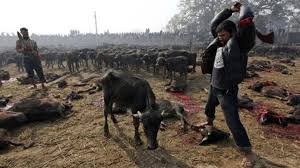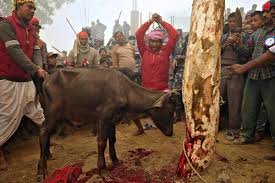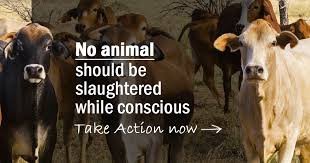INDISCRIMATE LIVESTOCK SLAUGHTER
@Livestock @Veterinary @Science

Livestock husbandry and slaughter have become a millenary tradition in every part of the world. The main reason for these traditions is that humans are at the top of the biological chain in the habit of meat consumption. This therefore serves as the foremost reason for maintaining animal populations to provide a nutritious and desirable form of food for people.
Although globally, the practice of slaughtering different breeds of livestock, the pregnancy status of the animal being slaughtered for meat still remains a hideous issue in many countries of the @world today. The scenario of animal slaughter in abattoirs has shown that not only the conventional non-breeding livestock are slaughtered for meat but also productive pregnant and lactating ones.

These animals are either killed for daily meals or occasionally for rituals, religious festivals, ceremonies, drug formulation, disease control or to meet immediate financial needs.
In the past, studies have been focused on: animal right, protection of animal welfare standards, conservation of animal’s genetic resources, Pre-slaughter Stress responsiveness , Abbattoir and Slaughter Surveillance, animal slaughter and next quality.
Obviously, these studies have made novel contribution to animal welfare and meat science in general yet; cases of slaughtering pregnant animals for meat production have not received adequate attention. This review will suggest the quantification of pain biomarkers as it aids the detection of humane slaughter of animals or quality assessment for preventing cruelty to animals at slaughter, curbing the extinction of meat species and respecting consumer's right.
The practice of animal slaughter to produce meat for consumption is inadvertently dated back to antiquity. This history behind the existence of public abattoirs had been traced to Roman civilization and France between 15th and 16th Centuries.
The law of 1890 in Italy required that public abattoirs be provided in all communities of more than six thousand inhabitants.
During the 1880’s and early 1890’s, the animal protectionist, veterinary and anti-Semitic societies in Saxony and in parts of Germany consequently lobbied for slaughter-house reforms. They sought the licensing of slaughterers and the restriction of the abattoir operation to men only. They also proposed the implementation of stricter inspection procedures and the stunning of animals, into a state of unconsciousness before their slaughter. These groups as well, called for change because they were convinced that the current state of affairs in the municipally-run slaughter houses posed a risk to the public’s health.

In their view, the activities at the abattoir allegedly encouraged cruel behaviour attracted in savouring characters from employees and were responsible for the accumulation of contaminants from it’s dirty and bloody surfaces.
Fraxion animal protectionists also expressed concern with the traditional ways in which animals were slaughtered for food. The concern later became Dutch veterinarians’ Motto Hominium animal unique saluti, “to the benefit of man and animal alike’ indicating their role in maintaining animal resources and protecting animal and human health.
Laws for the protection of animals existed in the Australian states before Australia’s federation in 1961 and remained the dominant policy instrument for animal welfare until the 1980’s. These laws were directed against cruelty which was interpreted as wilful or needless infliction of pain or spiteful neglect of the animal.
While the prevention of cruelty to animal act were revised regularly to keep pace with the time, it became apparent in the latter half of the twentieth century that these anti-cruelty acts provided insufficient protection for animal welfare.
This is because the subject of animal slaughter and their preslaughter welfare is considered to be very unpleasant.

Often, the personal concerned prefer not to know the details of what goes on inside a slaughter house or rather feed secured to conceal it in order to avoid controversy or suspicion. Therefore is need to call for monitoring committees in every country of the world to help reduce livestock brutal slaughter and wastage of animal proteins as fetuses.
Congratulations @damsel2great-sc! You have completed some achievement on Steemit and have been rewarded with new badge(s) :
Click on the badge to view your Board of Honor.
If you no longer want to receive notifications, reply to this comment with the word
STOPDo not miss the last post from @steemitboard!
Participate in the SteemitBoard World Cup Contest!
Collect World Cup badges and win free SBD
Support the Gold Sponsors of the contest: @good-karma and @lukestokes
You're making a big mistake my dear, inbox me ASAP..